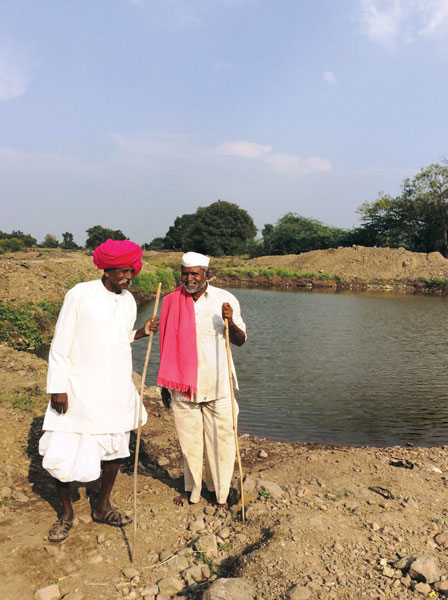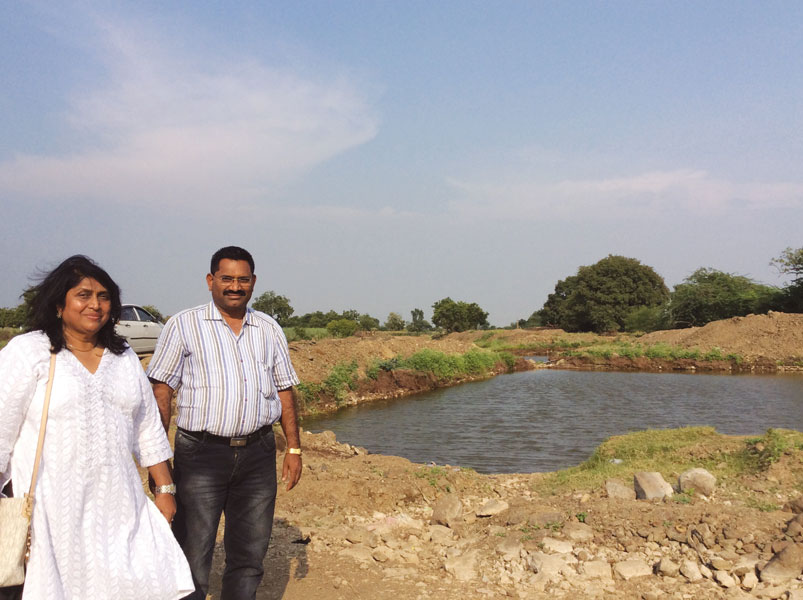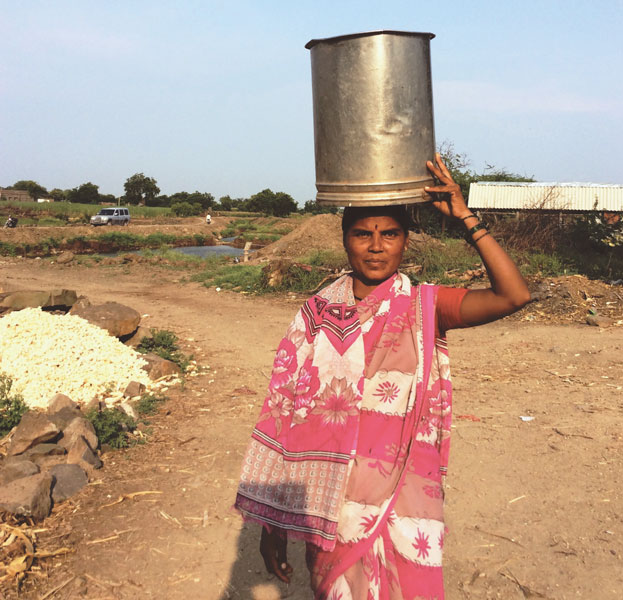Pune’s Jalpari

The first thing that strikes you about Rotarian Meena Borate, Past President of the Rotary Club of Pune Hillside, who is a medical doctor by profession, is her utmost honesty, no-nonsense approach, and the passion to execute whatever she has undertaken.
Today if under her dynamic leadership and the desire to help the underprivileged classes in Rotary District 3131 — farmers and other poor
people — have got both water for their farms and clean drinking water, through 16 projects funded by The Rotary Foundation for a whopping
Rs 63 lakh, there is an interesting story to relate.
A hard-nosed physician, her transition from a “businesswoman” as she calls herself, (“when we take money from our patients, aren’t we doing business; how can we call it service?”) to Pune’s jalpari (water fairy) began on that momentous day in the year 2001, when she attended a Rotary International meet in the US, accompanying her husband, Dr. Madhav Borate, then Governor of the District.
“In Rotary, we have training for spouses and I was reluctantly attending one for first ladies (spouses of Governors),” she recalls.
Some of the other spouses found out that Meena was a doctor and approached her saying they wanted to donate some money — Rs 27 lakh —
for helping children with eye problems in developing countries, so could she help.

Meena could not curse her hard luck enough. “I was already burdened with my own practice; my husband was Governor and had no time to spare for our hospital. But I also felt that God had sent me an opportunity to do something for poor children and if I refused it, I would be a bad human being,” she recalls.
So she undertook the project, learnt a lot from it, and more important, got hooked to the idea of community service.
Transition takes place
Jump to 2013; the hard-nosed businesswoman-cum-doctor had been transformed enough to donate Rs 17 lakh of her own money for charitable work through Rotary.
Meanwhile, Rotarians of RC Indapur in her District had been approached by the villagers of Tarangwadi and Gokhali, about 130 km from Pune, that the 4-km long stream that ran through their villages had run dry for several years and all the farmers — agriculture is the only activity — were suffering. With their crops failing due to insufficient water, land-owning farmers were forced to work as labourers in the fields in neighbouring villages, or migrating to cities, the sad but real story of Indian villages.

Meanwhile, Meena’s Rs 17 lakh had got a donation from one of her contacts within the Rotary world … a woman from Finland who raised
Rs 9 lakh from six countries. To this Rs 26 lakh was added $10,000 from the District Designated Funds when Rtn Deepak Shikarpur was Governor last year. As per RI norms, this money went to TRF and came back to Meena with a matching grant, swelling to Rs 63 lakh.
With this money the ‘Jalpari’ has managed to finance 16 water and sanitation projects in District 3131. One of the first beneficiaries were the villages Tarangwadi and Gokhali, where the farmers were in dire need of help as the drought conditions had virtually destroyed their land and livelihood; and Rotary Indapur undertook the project to bring water to them.
Enter Indapur Club
Fortunately the then RC Indapur President Vasant Malunjkar was an architect. He swung into action, did a rainwater harvesting survey of the stream and came out with a project cost of Rs 27 lakh. But he had to cut cost as all that Meena would spare was Rs 7 lakh; the club raised another Rs 1 lakh.
The dry stream was filled up with silt and thorny, wild foliage. The project involved digging of trenches 300 ft long, 50–60 ft wide and 10–12 ft deep. But at many places there was hard rock at a depth of 7 ft.
He not only had to cut cost but get the required government sanctions, and deal with sceptical villagers. As Meena puts it, “The villagers never believed the project would be done because they’re used to promises being broken by politicians. Above all, there was the suspicion that there must be something in it for the Rotarians, or else why would we do anything for them.”
But when they saw the work begin in July 2014, “most of the villagers waited in the scorching sun for three hours to see us; we were so touched,” she says.
On his part, Malunjkar’s biggest challenge was to cut costs dramatically. The biggest cost component was the use of excavators for desilting, removal of earth and rocks. The hourly rate for an excavator is Rs 2,600. But he found a Rotarian who owned excavators, and got two machines at an hourly rate of Rs 1,500.
“We worked day and night, the silt removed was taken away by the villagers at their own cost as it is fertile soil. The rocks were used to build a road alongside.”
Within a month, 37 pits (300 ft x 50 ft x12 ft) were created, leaving a gap of about 50 ft between each, and the cost of the project came down drastically to Rs 12 lakh. “Malunjkar wants the rest of the money — about Rs 4 lakh — but I have to finance the other 15 projects too,” laughs Meena, but promises to divert some funds to him, “if I have any surplus money left.”
Skies open up
Proving that the gods smile on the sincere and dedicated, “the very next day after we had completed work, it started raining heavily and continued for eight days, and all the pits filled up,” smiles Malunjkar, as he walks me along the water-filled pits.
Over 45 days have passed but the pits are filled with water; the larger objective of course was water percolation, which has happened naturally. The farmers I met confirmed that all their wells, empty for years, were now filled with water.
The result is that in the last seven weeks sowing of crops — sugarcane, vegetables such as tomatoes, capsicum, bananas, etc and exotic fruits such as pomegranate had already begun.
Saheb Rao Tarange, a grand old man of 80, with a bright red turban, gives me a wide toothless smile, beaming at the expanse of water before him. Seated on a bed-sheet spread in my honour under a shady village tree, with a one litre bottle of Coke on offer, he tells me how the villages had suffered from water shortage for years.
Now, with enough water in his well, he has planted on his 15-acre farm sugarcane, tomatoes, capsicum, etc and expects a good crop. Till now all of them — 5,000 inhabitants — could at best grow dry crops like jowar, bajra and maize.
As a woman carrying a large canister of water on her head, drawn from a hand pump next to the water pits, approaches, Meena explains how in months like October, drinking water came here only through water tankers. “But this year they have enough drinking water,” smiles Malunjkar.
The best part, he adds, is that even though these pits may dry up in the absence of rain, “the stream is strategically placed in the path of the canal water that is released for Indapur by the authorities thrice a year. So this stream and its pits will automatically fill up and percolate to the villagers’ wells. Nobody can stop it!”
Another local farmer, Tukaram Waghmode, who till last year used to work at the Mantralaya in Mumbai, is considered a village head, even though he is not the panchayat president. He owns seven acres of land and plans to cultivate four acres with pomegranate, a kg of which can fetch Rs 65 to Rs 150, depending on the quality. “With enough water and fertilisers, we can get 20 tons of fruit from one acre,” he adds.
But execution of 16 projects doesn’t mean Meena is resting on her laurels. Explaining the topography and the perennial problem of silt affecting water resources, she says desilting can get immediate and miraculous results. “But then how many times can we do this; Rotary resources are not limitless.”
A permanent solution is preventing erosion in hills. Deforestation and cutting of trees for firewood results in rains bringing down rich top soil, denuding hills and causing landslides. “We want to preserve the rich top soil by what is called continuous contour trenching, initially over 80 hectares of hills, and I have planned a project costing Rs 35 lakh.”
She already has collected this money, her motivation for such passionate work coming from growing up in an area adjacent to the Dharavi slum in Mumbai. “I watched during the monsoon all the sewage water entering their slum homes. And most of the people living there are villagers who have migrated in search of livelihoods. If they have a decent income in their village why would they come to lead such miserable lives in cities?”
Meanwhile in Tarangwadi/Gokhali, even though the recharging of their wells and availability of adequate water has lifted the farmers’ hopes of a good harvest, unfortunately the travails of the Indian farmer do not end there. Their next big hurdle is marketing and the huge profits made by the middlemen. Tarange, Waghmode and other farmers are worried about this too.
While there was no water, their land was lying fallow and they were forced to work as labourers in surrounding villages. Pune’s Jalpari’s dedication and passion have created optimism about a better future.
Tribhuvan Zagade, who owns 6.5 acres of land says that even though happy, they are bracing up for the next battle — marketing and middlemen depleting their incomes.
Pictures: Rasheeda Bhagat
Contact Meena Borate
at: + 91 9881477140
